sensor Peugeot Expert Tepee 2014 Owner's Manual
[x] Cancel search | Manufacturer: PEUGEOT, Model Year: 2014, Model line: Expert Tepee, Model: Peugeot Expert Tepee 2014Pages: 260, PDF Size: 13.44 MB
Page 4 of 260

2
Contents
Remote control 20Key 21Alarm 22Doors 23Instrument panel 27Adjusting the time 28Warning lamps 29
Fuel gauge 35Coolant 35Tyre under-inflation detection 36Service indicator 38Lighting dimmer 395-speed manual gearbox 406-speed manual gearbox 40Automatic gearbox 41Gear shift indicator 44Steering wheel adjustment 44Starting and stopping 45
Controls for 46 lighting 46 wipers 49Cruise control 51Fixed speed limiter 53Speed limiter 54Heating / air conditioning,
manual 57 digital 59Demisting and defrosting 63Rear ventilation 65Additional heating 66Seats 692-seat front bench 71Rear seats 73Seat and bench configuration 80Cab fittings 81Courtesy lamps 84Toll cards/car park tickets 85Seating area fittings 85Rear suspension 88Mirrors 91Electric windows 93
Presentation 4Exterior 6Sitting comfortably 11Seeing clearly 13Driving safely 14Cab fittings 15Rear fittings 15
Child safety 16Ventilation 17Eco-driving 18
Parking brake 94Hazard warning lamps 94Parking sensors 95Horn 96Anti-lock braking system (ABS) 96Emergency braking assistance 96ASR and DSC 97"Grip control" 98Seat belts 100Airbags 103Lateral airbags 105Front airbags 106Child seats 107Deactivating the passenger's front airbag 108ISOFIX mountings 111Recommended seats 115
2. READY TO SET OFF 20-454. SAFETY 94-1181. FAMILIARISATION 4-193. EASE OF USE and COMFORT 46-93
Page 9 of 260
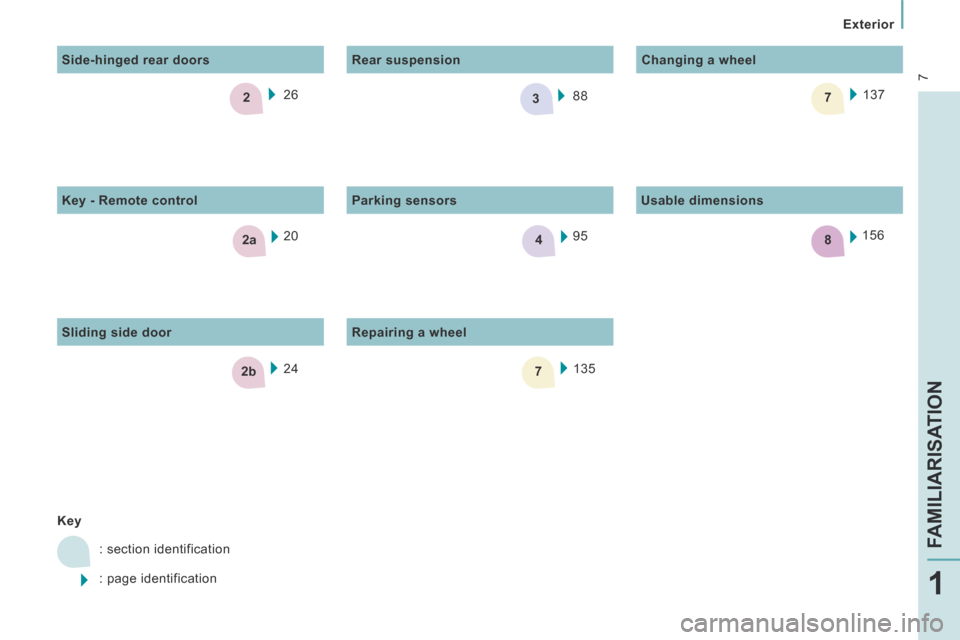
7
4
7
8
3
2b
2
2a
7
Exterior
FAMILIARISATION
1
Key
: section identification
: page identification 135
95
Rear suspension
Repairing a wheel Parking sensors
137
Changing a wheel
88
26
24 20
Side-hinged rear doors
Key - Remote control
Sliding side door
156
Usable dimensions
Page 12 of 260
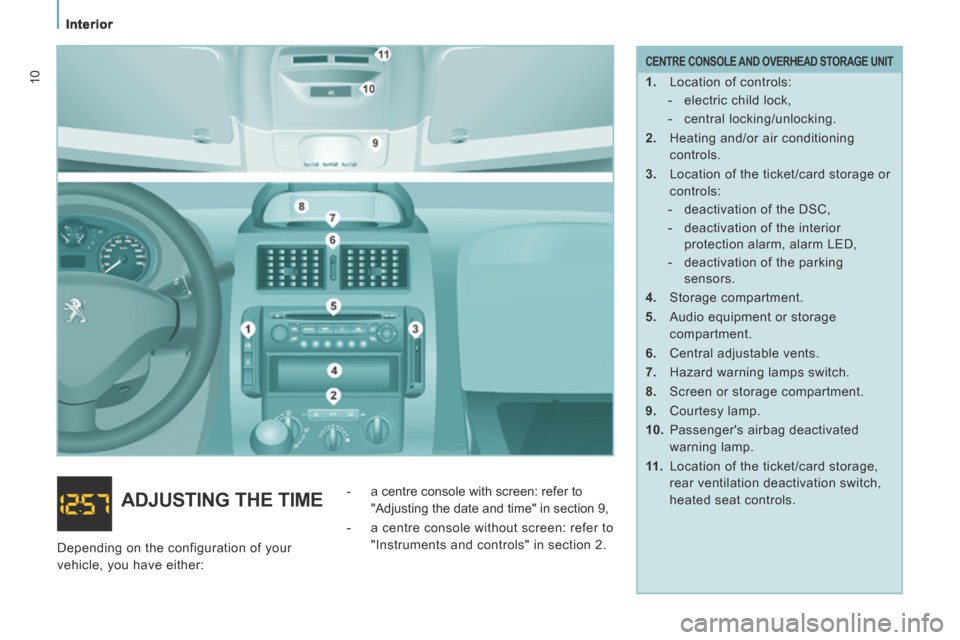
Interior
10
CENTRE CONSOLE AND OVERHEAD STORAGE UNIT
1. Location of controls: - electric child lock,
- central locking/unlocking.
2. Heating and/or air conditioning controls.
3. Location of the ticket/card storage or controls:
- deactivation of the DSC,
- deactivation of the interior protection alarm, alarm LED,
- deactivation of the parking sensors.
4. Storage compartment.
5. Audio equipment or storage compartment.
6. Central adjustable vents.
7. Hazard warning lamps switch.
8. Screen or storage compartment.
9. Courtesy lamp.
10. Passenger's airbag deactivated warning lamp.
11 . Location of the ticket/card storage,
rear ventilation deactivation switch,
heated seat controls.
ADJUSTING THE TIME - a centre console with screen: refer to "Adjusting the date and time" in section 9,
- a centre console without screen: refer to "Instruments and controls" in section 2.
Depending on the configuration of your
vehicle, you have either:
Page 32 of 260

30
Instruments and controls
Warning lamp is indicates Solution-action
Coolant
temperature
and level
on with needle in
the red zone.
abnormal increase in
temperature. Park, switch off the ignition then allow to cool. Visually
check the level.
flashing. drop in coolant level. Chapter 6, "Levels" section. Contact a PEUGEOT dealer
or a qualified workshop.
Service on temporarily.
minor faults or warnings. Consult the warnings log in the display or on the screen.
See chapter 9, "Trip computer" section then "Warnings
log".
Depending on the seriousness of the fault, contact a
PEUGEOT dealer or a qualified workshop.
remains on.
major faults.
Row 1 seat belt
not fastened
lit then flashing.
the driver or a front passenger
has not fastened his seat belt. Pull the strap then insert the tongue in the buckle.
accompanied by
an audible signal
then remains on. the vehicle is moving with the
driver or front passenger seat
belt not fastened. Check that the seat belt is fastened by pulling the strap.
Chapter 4, "Seat belts" section.
The driver must ensure that all passengers have
fastened their seat belt and use it correctly.
Under-inflation
detection
on.
a deflated or punctured tyre. Park and switch off the ignition. Change or repair the
wheel.
on,
accompanied
by the service
warning lamp. a faulty sensor.
Have it checked by a PEUGEOT dealer or a qualified
workshop.
Page 38 of 260
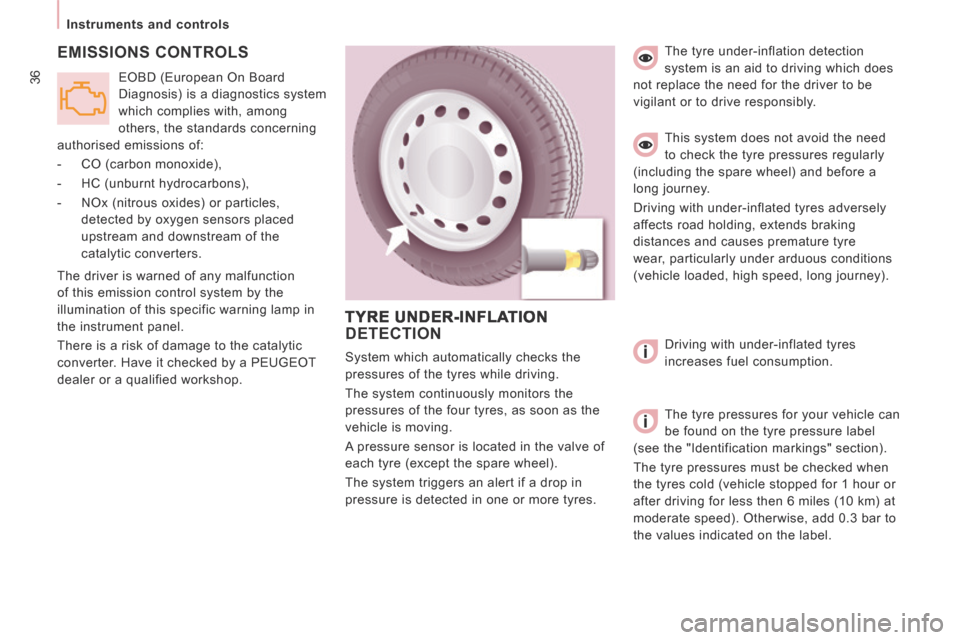
36
Instruments and controls
EMISSIONS CONTROLS
The driver is warned of any malfunction
of this emission control system by the
illumination of this specific warning lamp in
the instrument panel.
There is a risk of damage to the catalytic
converter. Have it checked by a PEUGEOT
dealer or a qualified workshop. EOBD (European On Board
Diagnosis) is a diagnostics system
which complies with, among
others, the standards concerning
authorised emissions of:
- CO (carbon monoxide),
- HC (unburnt hydrocarbons),
- NOx (nitrous oxides) or particles, detected by oxygen sensors placed
upstream and downstream of the
catalytic converters.
TYRE UNDER-INFLATION DETECTION
System which automatically checks the
pressures of the tyres while driving.
The system continuously monitors the
pressures of the four tyres, as soon as the
vehicle is moving.
A pressure sensor is located in the valve of
each tyre (except the spare wheel).
The system triggers an alert if a drop in
pressure is detected in one or more tyres. The tyre under-inflation detection
system is an aid to driving which does
not replace the need for the driver to be
vigilant or to drive responsibly.
This system does not avoid the need
to check the tyre pressures regularly
(including the spare wheel) and before a
long journey.
Driving with under-inflated tyres adversely
affects road holding, extends braking
distances and causes premature tyre
wear, particularly under arduous conditions
(vehicle loaded, high speed, long journey).
Driving with under-inflated tyres
increases fuel consumption.
The tyre pressures for your vehicle can
be found on the tyre pressure label
(see the "Identification markings" section).
The tyre pressures must be checked when
the tyres cold (vehicle stopped for 1 hour or
after driving for less then 6 miles (10 km) at
moderate speed). Otherwise, add 0.3 bar to
the values indicated on the label.
Page 39 of 260
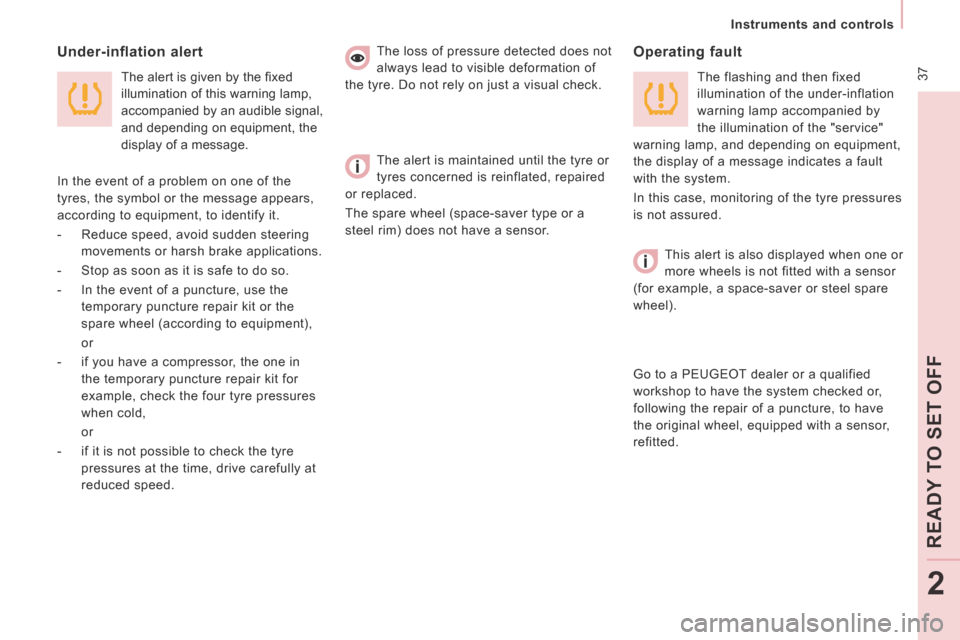
37
Instruments and controls
READ
Y T
O SET OFF
2
Under-inflation alert
The alert is given by the fi xed
illumination of this warning lamp,
accompanied by an audible signal,
and depending on equipment, the
display of a message.
In the event of a problem on one of the
tyres, the symbol or the message appears,
according to equipment, to identify it.
- Reduce speed, avoid sudden steering movements or harsh brake applications.
- Stop as soon as it is safe to do so.
- In the event of a puncture, use the temporary puncture repair kit or the
spare wheel (according to equipment),
or
- if you have a compressor, the one in the temporary puncture repair kit for
example, check the four tyre pressures
when cold,
or
- if it is not possible to check the tyre pressures at the time, drive carefully at
reduced speed. The loss of pressure detected does not
always lead to visible deformation of
the tyre. Do not rely on just a visual check.
The alert is maintained until the tyre or
tyres concerned is reinflated, repaired
or replaced.
The spare wheel (space-saver type or a
steel rim) does not have a sensor.
Operating fault
The flashing and then fixed
illumination of the under-inflation
warning lamp accompanied by
the illumination of the "service"
warning lamp, and depending on equipment,
the display of a message indicates a fault
with the system.
In this case, monitoring of the tyre pressures
is not assured.
This alert is also displayed when one or
more wheels is not fitted with a sensor
(for example, a space-saver or steel spare
wheel).
Go to a PEUGEOT dealer or a qualified
workshop to have the system checked or,
following the repair of a puncture, to have
the original wheel, equipped with a sensor,
refitted.
Page 48 of 260

46
Steering mounted controls
Dipped beam/main beam change
Pull the stalk fully towards you. Automatic illumination of headlamps
if your vehicle is fi tted with a
sunshine sensor. Lighting off
Dipped beam (green)
Main beam (blue) LIGHTING CONTROL STEERING MOUNTED CONTROLS
Sidelamps
Lighting-on audible warning
When the ignition is switched off, when
the driver's door is opened, there is an
audible warning if you have left the vehicle's
lighting on.
DIRECTION INDICATORS (flashing indicators)
Left : downwards passing
the point of resistance.
Right : upwards passing
the point of resistance.
Front and rear lamps
Selection is by turning ring A .
Checking by means of the indicator
lamps in the instrument panel is
described in the "Instruments and
controls" section of chapter 2.
Page 50 of 260
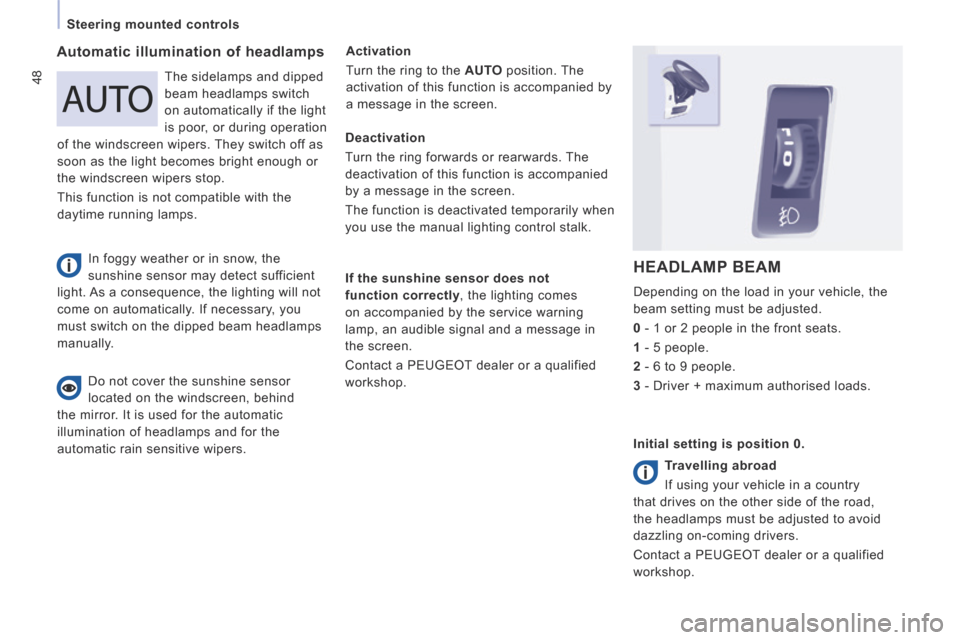
48
Steering mounted controls
Automatic illumination of headlamps Activation
Turn the ring to the AUTO position. The
activation of this function is accompanied by
a message in the screen.
If the sunshine sensor does not
function correctly , the lighting comes
on accompanied by the service warning
lamp, an audible signal and a message in
the screen.
Contact a PEUGEOT dealer or a qualified
workshop.
HEADLAMP BEAM
Depending on the load in your vehicle, the
beam setting must be adjusted.
0 - 1 or 2 people in the front seats.
1 - 5 people.
2 - 6 to 9 people.
3 - Driver + maximum authorised loads.
Do not cover the sunshine sensor
located on the windscreen, behind
the mirror. It is used for the automatic
illumination of headlamps and for the
automatic rain sensitive wipers. The sidelamps and dipped
beam headlamps switch
on automatically if the light
is poor, or during operation
of the windscreen wipers. They switch off as
soon as the light becomes bright enough or
the windscreen wipers stop.
This function is not compatible with the
daytime running lamps. Deactivation
Turn the ring forwards or rearwards. The
deactivation of this function is accompanied
by a message in the screen.
The function is deactivated temporarily when
you use the manual lighting control stalk.
Initial setting is position 0.
In foggy weather or in snow, the
sunshine sensor may detect sufficient
light. As a consequence, the lighting will not
come on automatically. If necessary, you
must switch on the dipped beam headlamps
manually.
Travelling abroad
If using your vehicle in a country
that drives on the other side of the road,
the headlamps must be adjusted to avoid
dazzling on-coming drivers.
Contact a PEUGEOT dealer or a qualified
workshop.
Page 51 of 260
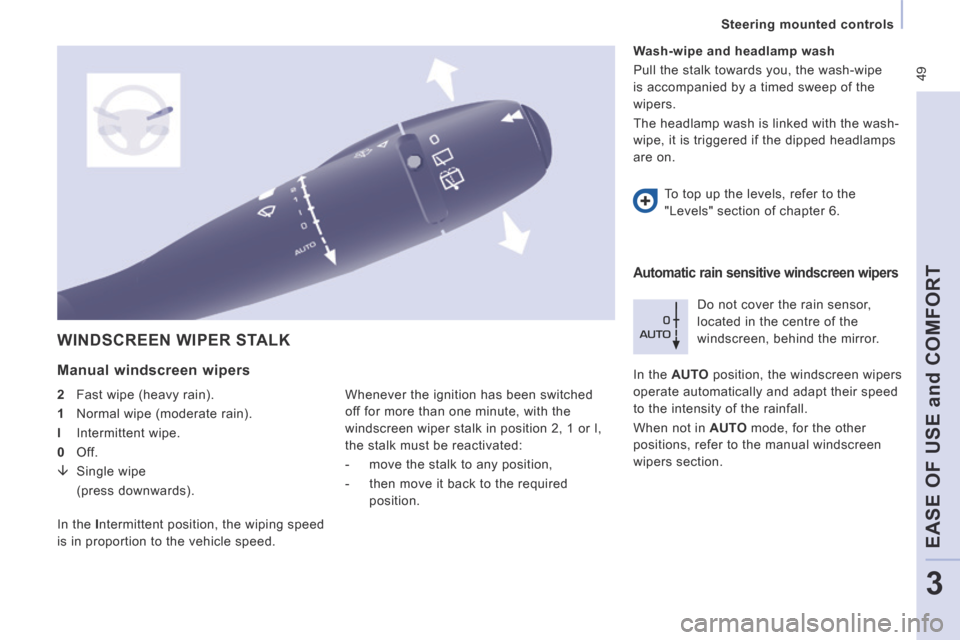
49
Steering mounted controls
EASE OF USE
and
COMFORT
3
WINDSCREEN WIPER STALK
Manual windscreen wipers
2 Fast wipe (heavy rain).
1 Normal wipe (moderate rain).
l Intermittent wipe.
0 Off.
Single wipe
(press downwards). Do not cover the rain sensor,
located in the centre of the
windscreen, behind the mirror.
In the AUTO position, the windscreen wipers
operate automatically and adapt their speed
to the intensity of the rainfall.
When not in AUTO mode, for the other
positions, refer to the manual windscreen
wipers section.
In the I ntermittent position, the wiping speed
is in proportion to the vehicle speed. Wash-wipe and headlamp wash
Pull the stalk towards you, the wash-wipe
is accompanied by a timed sweep of the
wipers.
The headlamp wash is linked with the wash-
wipe, it is triggered if the dipped headlamps
are on.
To top up the levels, refer to the
"Levels" section of chapter 6.
Automatic rain sensitive windscreen wipers
Whenever the ignition has been switched
off for more than one minute, with the
windscreen wiper stalk in position 2, 1 or I,
the stalk must be reactivated:
- move the stalk to any position,
- then move it back to the required position.
Page 62 of 260
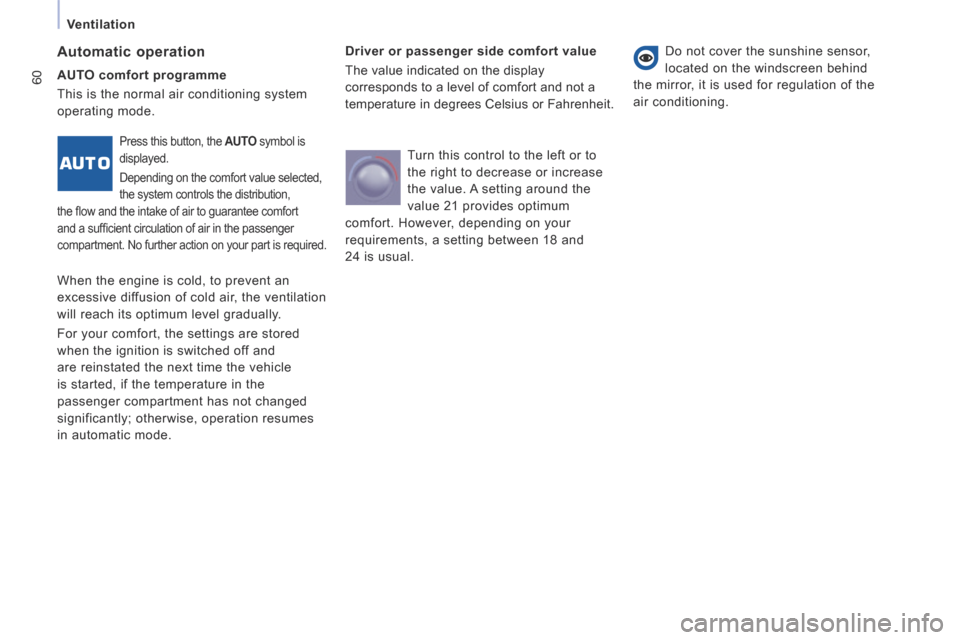
60
Ventilation
Driver or passenger side comfort value
The value indicated on the display
corresponds to a level of comfort and not a
temperature in degrees Celsius or Fahrenheit. Automatic operation Do not cover the sunshine sensor,
located on the windscreen behind
the mirror, it is used for regulation of the
air conditioning.
AUTO comfort programme
This is the normal air conditioning system
operating mode.
Press this button, the
AUTO symbol is
displayed.
Depending on the comfort value selected,
the system controls the distribution,
the fl ow and the intake of air to guarantee comfort
and a suffi cient circulation of air in the passenger
compartment. No further action on your part is required.
When the engine is cold, to prevent an
excessive diffusion of cold air, the ventilation
will reach its optimum level gradually.
For your comfort, the settings are stored
when the ignition is switched off and
are reinstated the next time the vehicle
is started, if the temperature in the
passenger compartment has not changed
significantly; otherwise, operation resumes
in automatic mode. Turn this control to the left or to
the right to decrease or increase
the value. A setting around the
value 21 provides optimum
comfort. However, depending on your
requirements, a setting between 18 and
24 is usual.